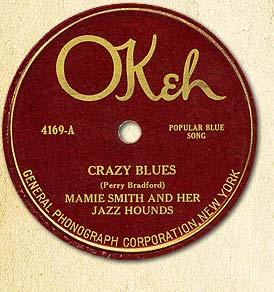Biography:

Although little is known about her early years, scholars believe that Smith was born Mamie Robinson in Cincinnati, Ohio in 1883. By the age of 10 she was working as a vaudeville entertainer and touring with the Four Dancing Mitchells. She continued to tour with various acts throughout her teens. By 1913 at the age of 20 she was living and working in Harlem and soon after married William “Smithy” Smith. She remarried twice after her career took off (Garner, 2018).
Obstacles of Race:
A newspaper article by a black writer from 1921 talks about the exploitation of black musicians by phonograph companies. The companies used these musicians of color to sell blues music to black record buyers, but still excluded other musicians of color who performed different kinds of music. This picking and choosing of what music to produce and sell contributes to the problem of erasure in black music. There are certain kinds of music that are recorded and preserved, but others aren’t, even if they are equally important (Kenny, 2017).
ALTHOUGH,
Mamie Smith’s record was purchased by black and white consumers and was recognized as a lucrative marketing segment by studios and record company executives (Garner, 2017).
Mamie Smith’s Significance:

Mamie Smith was the first to record blues songs in 1920 with her versions of Perry Bradford’s “Crazy Blues”, and “It’ s Right Here for You” on Okeh Records. The record was a wild success, selling over a million copies in less than a year, and finally ending up selling over two

million copies (Red Hot Jazz, 2018). Mamie Smith’s music seemed to open up the eyes of those around her. Record companies thought there was a lot of money to be made selling what was then called “race records” to various minority groups in big cities. The success of “Crazy Blues” prompted other record companies to also try to find other female blues singers that could match the sales of “Crazy Blues”. It was a very important record, because it opened the doors of the recording industry to African-Americans, whether they were Blues, Jazz or popular singers or musicians. Smith herself really wasn’t that much of a Blues singer (Red Hot Jazz, 2018). Mamie Smith’s music was loved for many reasons. “Crazy Blues”, represents the emergence of black female singers into popular music culture and was therefore a very important contribution to black music. Her pioneering musical career paved the way for more successful female blues and jazz artists like “Ma” Rainey, Bessie Smith (no relation), and Billie Holiday (Garner, 2018).
Success:
Smith’s amount of success and talent was unbelievable. Smith found herself suddenly wealthy, and she spent much of her earnings on clothes, jewelry, real estate,

and servants (Garner, 2018). With all this Mamie Smith mania, New York City suddenly became the blues recording capital of the world. Mamie Smith records have enjoyed tremendous sale in all parts of the country.Mamie Smith and her jazz hounds came, saw, and conquered in Chicago during the month of February. She played to large audiences on the South Side at the Avenue Theatre with immense success.In Mamie Smith’s prime, her stage appearances netted her up to $1,500 a week. Bedecked in diamonds, plumes, and a shimmering gown, she could get a standing ovation just by strutting across the stage (Jasobrecht, 2018). Mamie Smith overall made a historic mark on the musical world that lead women in the right direction to pursue their own music.
Crazy Blues
This was a song about being in a relationship and the love and heartbreak that can go along with it. Throughout this song she wears her emotions on her sleeve about the love she has for a man. Although she also expresses that the love isn’t reciprocated and that he doesn’t treat her right. This song is significant because it was the first blues song recorded and was also recorded by a female which was the first step for black female vocalists.
That Thing Called Love
This song was also a very popular hit of Mamie Smith’s and was her first song recored for OKEH Records. It has a slower pace and is clearly another love song.
Don’t Care Blues
This song opens up with a wide variety of instruments that catches your attention and ear instantly. Immediately when Mamie Smith begins to sing the lyrics speak to you about being down and out.
Works Cited:
Garner, Carla. “Smith, Mamie.” Black Past. Retrieved July 15th, 2018. http://www.blackpast.org/aah/smith-mamie-1883-1946
Kenny, Grace. “Mamie Smith’s Crazy Blues.” October 10th, 2017. Retrieved July 15th, 2018. https://pages.stolaf.edu/americanmusic/tag/mamie-smith/
“Mamie Smith.” Retrieved July 15th, 2018. http://www.redhotjazz.com/mamie.html
“Mamie Smith: The First Lady of the Blues.” Retrieved July 15th, 2018. http://jasobrecht.com/mamie-smith-the-first-lady-of-the-blues/




 musical recordings for Okeh withing the 1920’s. She did a tour with her band, “Mamie Smith & Her Jazz Hounds” in the United States and in Europe. She developed a name called, “The Queen of the Blues”, with her utter most talent in the music Industry.
musical recordings for Okeh withing the 1920’s. She did a tour with her band, “Mamie Smith & Her Jazz Hounds” in the United States and in Europe. She developed a name called, “The Queen of the Blues”, with her utter most talent in the music Industry. 